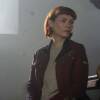Nolly shows the real life story of Noele Gordon withstanding an unjust firing from the UK soap opera Crossroads and her journey back toward being a leading lady. In contrast, Funny Woman recently showed up-and-coming comedian Barbara transforming herself into Sophie Straw. If you liked these recent MASTERPIECE and PBS series, you’re in luck: they are far from the only shows to depict the early days of the modern British TV industry. This article aims to recommend what to watch after Nolly and discuss how each series dramatized behind-the-scenes and in-front-of-the-camera drama.
A decade ago, The Hour portrayed the first generation of investigative journalists on BBC TV news. Doctor Who’s extended universe has also contributed commentary to the beginnings of British television via the recent 60th Anniversary special “The Giggle” (also written by Nolly screenwriter Russell T. Davies) and the 2013 50th Anniversary special An Adventure in Space and Time (written by Nolly and Sherlock actor Mark Gatiss), which dramatized the story of how the series almost didn’t survive its early years. Funny Woman and The Hour have fictional characters representing real reporters and entertainment personalities from the era. Nolly and An Adventure in Space and Time feature fictionalized versions of real events, people, and trends.

The Hour, which premiered in 2011, is set in 1957 and stars Romola Garolai (The Miniaturist) as Bel Rowley, the first female TV producer at the BBC. She works much harder than the good ‘ole boys club gives her credit for. Ben Whishaw (The Hollow Crown) plays the young and often too eager reporter/anchor Freddie Lyon who doesn’t always listen to Bel’s advice. Dominic West (Les Misérables) plays senior anchor Hector Madden — the person most emblematic of the misogyny of the era. Their investigative reporting work in the first season eventually leads to the uncovering of a Communist conspiracy and, in the second season, worker exploitation, racism, and other issues. Many critics at the time called The Hour the UK’s answer to Mad Men, but this comparison doesn’t give justice to the show’s journalism and political plots.

An Adventure In Time And Space stars Jessica Raine (Call The Midwife) as Doctor Who’s first female producer Verity Lambert, Sacha Dhawan (Mr. Selfridge) as director Waris Hussein, and Brian Cox (Marple) as creator and producer Sydney Newman: the trio who formed the core of the show’s first production team in 1963. David Bradley (Les Misérables) plays the First Doctor William Hartnell. This production is the most fondly nostalgic of the early days of television because it was made as a tribute to Doctor Who as a UK cultural institution by and for the fans.
While all of the series succeed in showcasing the on-set experience, the process from start to finish varies depending on the genre of the final product. All of the series feature meetings to plan an episode, then film the content for the episode, followed by post-production. Unusually, Funny Woman was filmed in front of an audience, and The Hour was involved in one public affairs debate. The dramatic tension for all of these characters comes from disagreements in the planning and execution process, followed by reactions to ratings and critics. The Hour also has the additional volatile element of live, pre-recorded, and off-camera interviews going awry because interview subjects either lie or are scared to tell the truth.
“The Giggle” and Nolly are connected by both depicting John Logie Baird’s early experiments with color television. Nolly posing for Baird’s device is the far more realistic depiction. “The Giggle” takes the situation to an extreme, with Baird’s very first experiment televising an image of the puppet Stooky Bill with sound as the conduit for Neil Patrick Harris’ alien villain The Toymaker to invade London.

The different ways that women face the glass ceiling is the theme that unites all of the series. Bel’s struggles to separate her dating life from her work life is something she has in common with Sophie/Barbara, and Nolly as well. Abi Morgan’s scripts for The Hour were developed way before the #MeToo movement, making some plotlines even more resonant than when the series first aired due to the uncovering of sexual harassment in newsrooms on both sides of the Atlantic. Verity Lambert is possibly the historical inspiration for Bel, despite the differences between scripted television and broadcast journalism. Lambert also experiences pushback from the men who believe she’s incapable of successfully leading the Doctor Who episode team in An Adventure in Space and Time.
Similarly, it can be argued that Waris Hussein may be the real-life inspiration for Dennis Mohindra’s character in Funny Woman. Both Hussein and Mohindra are the only visible people of color in their work environment. It should be noted that Doctor Who creator and producer Sydney Newman was Jewish, and while he would have faced antisemitism, he would not have the same slurs directed at him. Both series depict micro and macro aggressions, although Dennis has a harder creative life with having to rewrite a toned-down stereotyped South Asian character. The only major difference is that Hussein is also gay, so the love triangle factor on Funny Woman is likely based on someone else from the era.
All of the series in this comparison are excellent choices for viewers who want to continue the meta British Television theme of Nolly. An Adventure in Space and Time and “The Giggle” have a more comforting, whimsical vibe, while The Hour is sober and unflinching. Funny Woman is more comedic at times, but also has the most thematic parallels to Nolly and could very well stand in for what was left out about the middle stages in Noele Gordon’s career.
Where to watch:
'Nolly', 'Funny Woman', and 'The Hour' are all available to members with PBS Passport. An Adventure In Time And Space is currently streaming on BritBox and BritBox on Prime. The Giggle is currently streaming on Disney+.





